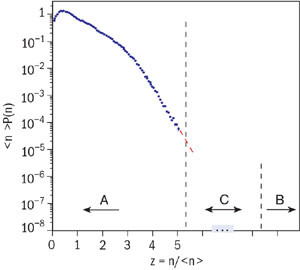
The collisions produced by the new generation of high-energy hadron machines – Fermilab’s revamped Tevatron for protons on antiprotons, Brookhaven’s RHIC for heavy ions and CERN’s LHC for protons and heavy ions – create (or will create) lots of secondary particles. The study of these high-multiplicity collisions is a central feature of modern particle physics.
More than 90% of the events in high-energy experiments are inelastic, providing a broad background for more specific processes investigated using the conventional Standard Model. A “new” approach highlights a seldom investigated region of Very High Multiplicity (VHM) physics.
Although producing many particles, these VHM events (region C in the figure) are rare, making up only about 10-7 of the total cross-section at the LHC energy. However, their investigation is thought to be extremely important, not only as background for modern experiments, but also to address fundamental questions.
In principle, all of the collision energy is available to make new particles. However, in practice, most of the secondary particles emerge carrying a lot of kinetic energy, so that less energy is available for the production of additional particles.
What suppresses the production of additional particles?
Confining attention to the small VHM region where many additional particles are created could help to elucidate the question and possibly shed more light on the underlying colour charge confinement phenomenon.
VHM processes may also have played an important role in the evolution of the universe in the immediate aftermath of the Big Bang, because VHM states may be produced only via a high-energy density of initial states. The VHM states have remarkable “calmness” and “coldness”, and they provide a bridge between kinetic energy and rest mass.
An initial approach is to look at multiple hadron production as a thermal dissipation of incident kinetic energy into produced mass, using Schwinger-Keldysh real-time thermodynamics (Manjavidze and Sissakian 2001). This has analogies with previous work by Bogolyubov.
This shows that the domain where complete thermalization is achieved is just the VHM domain. If so, the minority VHM physics may be especially “simple”. However, standard physics approaches are no longer valid for these rare processes. Recent workshops in Dubna and in Varna, Bulgaria focused on these questions.
With so much understanding at stake, it is important that experiments at the LHC, the Tevatron and the RHIC turn their attention to this problem. The third workshop on VHM physics will held in Dubna on 3-6 June 2002.
Further reading
J Manjavidze and A Sissakian 2001 Phys. Rep. 346 1.







